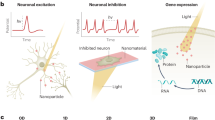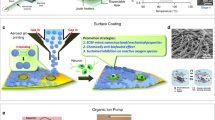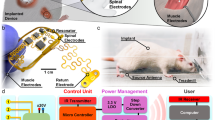Abstract
Magnetoelectric materials convert magnetic fields into electric fields. These materials are often used in wireless electronic and biomedical applications. For example, magnetoelectrics could enable the remote stimulation of neural tissue, but the optimal resonance frequencies are typically too high to stimulate neural activity. Here we describe a self-rectifying magnetoelectric metamaterial for a precisely timed neural stimulation. This metamaterial relies on nonlinear charge transport across semiconductor layers that allow the material to generate a steady bias voltage in the presence of an alternating magnetic field. We generate arbitrary pulse sequences with time-averaged voltage biases in excess of 2 V. As a result, we can use magnetoelectric nonlinear metamaterials to wirelessly stimulate peripheral nerves to restore a sensory reflex in an anaesthetized rat model and restore signal propagation in a severed nerve with latencies of less than 5 ms. Overall, these results showing the rational design of magnetoelectric metamaterials support applications in advanced biotechnology and electronics.
This is a preview of subscription content, access via your institution
Access options
Access Nature and 54 other Nature Portfolio journals
Get Nature+, our best-value online-access subscription
$29.99 / 30 days
cancel any time
Subscribe to this journal
Receive 12 print issues and online access
$259.00 per year
only $21.58 per issue
Buy this article
- Purchase on Springer Link
- Instant access to full article PDF
Prices may be subject to local taxes which are calculated during checkout





Similar content being viewed by others
Data availability
All the relevant data supporting the results of this study are presented in the Article or its Supplementary Information. Raw data are available at https://osf.io/yr78v/.
Code availability
Custom code used in this study is available at https://osf.io/yr78v/.
References
Hallett, M. et al. Transcranial magnetic stimulation and the human brain. Nature 406, 147–150 (2000).
Chen, R. et al. Wireless magnetothermal deep brain stimulation. Science 347, 1477–1480 (2015).
Huang, H. et al. Remote control of ion channels and neurons through magnetic-field heating of nanoparticles. Nat. Nanotechnol. 5, 602–606 (2010).
Munshi, R. & Pralle, A. Remote modulation of neuronal cells in the brain. Nat. Mater. 20, 912–913 (2021).
Moon, J. et al. Magnetothermal multiplexing for selective remote control of cell signaling. Adv. Funct. Mater. 30, 2000577 (2020).
Sebesta, C. et. al. Subsecond multichannel magnetic control of select neural circuits in freely moving flies. Nat. Mater. 21, 951–958 (2022).
Rao, S. et al. Remotely controlled chemomagnetic modulation of targeted neural circuits. Nat. Nanotechnol. 14, 967–973 (2019).
Boyden, E. S. et al. Millisecond-timescale, genetically targeted optical control of neural activity. Nat. Neurosci. 8, 1263–1268 (2005).
Bhave, G. et al. Distributed sensor and actuator networks for closed-loop bioelectronic medicine. Mater. Today 46, 125–135 (2021).
Gregurec, D. et al. Magnetic vortex nanodiscs enable remote magnetomechanical neural stimulation. ACS Nano 14, 8036–8045 (2020).
Dobson, J. et al. Remote control of cellular behaviour with magnetic nanoparticles. Nat. Nanotechnol. 3, 139–143 (2008).
Lee, J. et al. Non-contact long-range magnetic stimulation of mechanosensitive ion channels in freely moving animals. Nat. Mater. 20, 1029–1036 (2021).
Nguyen, T. et al. In vivo wireless brain stimulation via non-invasive and targeted delivery of magnetoelectric nanoparticles. Neurotherapeutics 18, 2091–2106 (2021).
Kozielski, K. et al. Nonresonant powering of injectable nanoelectrodes enables wireless deep brain stimulation in freely moving mice. Sci. Adv. 7, eabc4189 (2021).
Tu, C. et al. Mechanical-resonance-enhanced thin-film magnetoelectric heterostructures for magnetometers, mechanical antennas, tunable RF inductors, and filters. Materials 12, 2259 (2019).
Grossman, N. et al. Noninvasive deep brain stimulation via temporally interfering electric fields. Cell 169, 1029–1041.E16 (2017).
Singer, A. et al. Magnetoelectric materials for miniature, wireless neural stimulation at therapeutic frequencies. Neuron 107, 631–643 (2020).
Yu, Z. et al. MagNI: a magnetoelectrically powered and controlled wireless neurostimulating implant. IEEE Trans. Biomed. Circuits Syst. 14, 1241–1252 (2020).
Alrashdan, F. et al. Wearable wireless power systems for ‘ME-BIT’ magnetoelectric-powered bio implants. J. Neural Eng. 18, 045011 (2021).
Chen, J. C. et al. Wireless endovascular nerve stimulation with a millimeter-sized magnetoelectric implant. Nat. Biomed. Eng. 6, 706–716 (2022).
Li, Z. et al. In situ ZnO nanowire growth to promote the PVDF piezo phase and the ZnO-PVDF hybrid self-rectified nanogenerator as a touch sensor. Phys. Chem. Chem. Phys. 16, 5475–5479 (2014).
Kang, B. J. et al. Ultrafast and low-threshold THz mode switching of two-dimensional nonlinear metamaterials. Nano Lett. 22, 2016–2022 (2022).
Misewich, J. A. et al. Electrically induced optical emission from a carbon nanotube FET. Science 300, 783–786 (2003).
Lincoln, R. et al. Multifunctional composites: a metamaterial perspective. Multifunct. Mater. 2, 043001 (2019).
Cuong, T. D. et al. Giant magnetoelectric effects in serial-parallel connected Metglas/PZT arrays with magnetostrictively homogeneous laminates. J. Sci. Adv. Mater. Devices 5, 354–360 (2020).
Park, Y. et al. Unidirectional oxide hetero-interface thin-film diode. Appl. Phys. Lett. 107, 143506 (2015).
Krajewski, T. A. et al. Hafnium dioxide as a passivating layer and diffusive barrier in ZnO/Ag Schottky junctions obtained by atomic layer deposition. Appl. Phys. Lett. 98, 263502 (2011).
Brillson, L. J. & Lu, Y. ZnO Schottky barriers and ohmic contacts. J. Appl. Phys. 109, 121301 (2011).
Mondal, S. et al. Preparation of ZnO Film on p-Si and I-V characteristics of p-Si/n-ZnO. Mater. Res. 16, 94–99 (2013).
Guziewicz, E. et al. ALD grown zinc oxide with controllable electrical properties. Semicond. Sci. Technol. 27, 074011 (2012).
Jeon, S. et al. Structural and electrical properties of ZnO thin films deposited by atomic layer deposition at low temperatures. J. Electrochem. Soc. 155, H738–H743 (2008).
Xie, X. et al. Long-term reliability of Al2O3 and parylene C bilayer encapsulated Utah electrode array based neural interfaces for chronic implantation. J. Neural Eng. 11, 026016 (2014).
Pak, A. et al. Thin film encapsulation for LCP-based flexible bioelectronic implants: comparison of different coating materials using test methodologies for life time estimation. Micromachines 13, 544 (2022).
Prominski, A. et al. Porosity-based heterojunctions enable leadless optoelectronic modulation of tissues. Nat. Mater. 21, 647–655 (2022).
Cummer, S. A. et al. Controlling sound with acoustic metamaterials. Nat. Rev. Mater. 1, 16001 (2016).
Suchowski, H. et al. Phase mismatch-free nonlinear propagation in optical zero-index materials. Science 342, 1223–1226 (2013).
Canalias, C. & Pasiskevicius, V. Mirrorless optical parametric oscillator. Nat. Photon. 1, 459–462 (2007).
Shalaev et al. Optical negative-index metamaterials. Nat. Photon. 1, 41–48 (2007).
Surjadi, J. et al. Mechanical metamaterials and their engineering applications. Adv. Eng. Mater. 21, 1800864 (2019).
Montgomery, S. et al. Magneto-mechanical metamaterials with widely tunable mechanical properties and acoustic bandgaps. Adv. Funct. Mater. 31, 2005319 (2020).
Hu, J. Z. et al. Crystal data for high-pressure phases of silicon. Phys. Rev. B 34, 4679 (1986).
Ahmed, N. Numerical analysis of transport properties of ZnO based Schottky diode. Phys. Scr. 96, 065211 (2021).
Wang, B. et al. Multichannel power electronics and magnetic nanoparticles for selective thermal magnetogenetics. J. Neural Eng. 19, 026015 (2022).
Acknowledgements
We would like to acknowledge A. Singer, A. Tuppen, M. Parker and V. Nair for their useful discussions on magnetoelectrics. We would also like to acknowledge E. C. Lai for his assistance with the rat nerve surgeries, S. Coffler for her assistance with the biocompatibility assay and A. Bayles for his assistance with the X-ray diffraction measurements. We also thank the staff at the Shared Equipment Authority (SEA) at Rice University, as well as T. Gilheart, J. Guo, J. Kerwin and H. Guo, for their assistance and excellent discussions. We acknowledge funding from the National Science Foundation ECCS-2023849 (G.B., J.C.C., F.A. and J.T.R.), National Institutes of Health U18EB029353 (G.B., J.C.C., F.A. and J.T.R.) and National Institutes of Health F31 DE030333 (K.J.H. and A.G.M.).
Author information
Authors and Affiliations
Contributions
J.C.C., G.B. and J.T.R. conceived the MNM concept. J.T.R. supervised the research. J.C.C. and G.B. completed a majority of the experiments and data collection. F.A., A.D., K.J.H. and A.G.M. assisted with the material characterization. J.C.C., G.B. and J.T.R. prepared the manuscript with input from all the authors. F.A. reviewed and edited the manuscript.
Corresponding author
Ethics declarations
Competing interests
J.T.R. is a co-founder of Motif Neurotech, Inc., where he has an equity stake and receives compensation. The views presented here should not be considered as endorsements of any specific product or company. The remaining authors declare no competing interests.
Peer review
Peer review information
Nature Materials thanks Shad Roundy and the other, anonymous, reviewer(s) for their contribution to the peer review of this work.
Additional information
Publisher’s note Springer Nature remains neutral with regard to jurisdictional claims in published maps and institutional affiliations.
Supplementary information
Supplementary Information
Supplementary Figs. 1–23.
Supplementary Video 1
Toe-pinch experiment.
Supplementary Video 2
Severed nerve.
Supplementary Video 3
Open wound.
Supplementary Video 4
Closed wound.
Supplementary Video 5
Thermal imaging.
Rights and permissions
Springer Nature or its licensor (e.g. a society or other partner) holds exclusive rights to this article under a publishing agreement with the author(s) or other rightsholder(s); author self-archiving of the accepted manuscript version of this article is solely governed by the terms of such publishing agreement and applicable law.
About this article
Cite this article
Chen, J.C., Bhave, G., Alrashdan, F. et al. Self-rectifying magnetoelectric metamaterials for remote neural stimulation and motor function restoration. Nat. Mater. 23, 139–146 (2024). https://doi.org/10.1038/s41563-023-01680-4
Received:
Accepted:
Published:
Issue Date:
DOI: https://doi.org/10.1038/s41563-023-01680-4
This article is cited by
-
Neuromorphic hardware for somatosensory neuroprostheses
Nature Communications (2024)



